Chemical Management & WHS Monitoring Processes Case Study Analysis
VerifiedAdded on 2023/06/08
|17
|2733
|295
Case Study
AI Summary
This case study delves into the hazardous chemical management and WHS monitoring processes at Youngwood Day Centre, focusing on an incident involving Hypochlor use. It addresses legislative requirements, risk assessment, hazard identification, and the importance of Safety Data Sheets (SDS). The study highlights the responsibilities of managers and supervisors in maintaining workplace safety, including implementing operational policies and training staff. It analyzes the incident at Youngwood Day Centre, emphasizing hazard and risk identification, incident investigation, and the implementation of control measures based on the hierarchy of control. The case study further examines the health hazards, handling, storage, and PPE requirements for Hypochlor, referencing the manufacturer's SDS. Finally, it provides a risk control implementation plan and a risk register, outlining necessary actions, resources, and responsible personnel to mitigate chemical hazards, aiming to minimize negative effects and ensure a safer working environment. Desklib provides a platform for students to access this and other solved assignments and past papers.
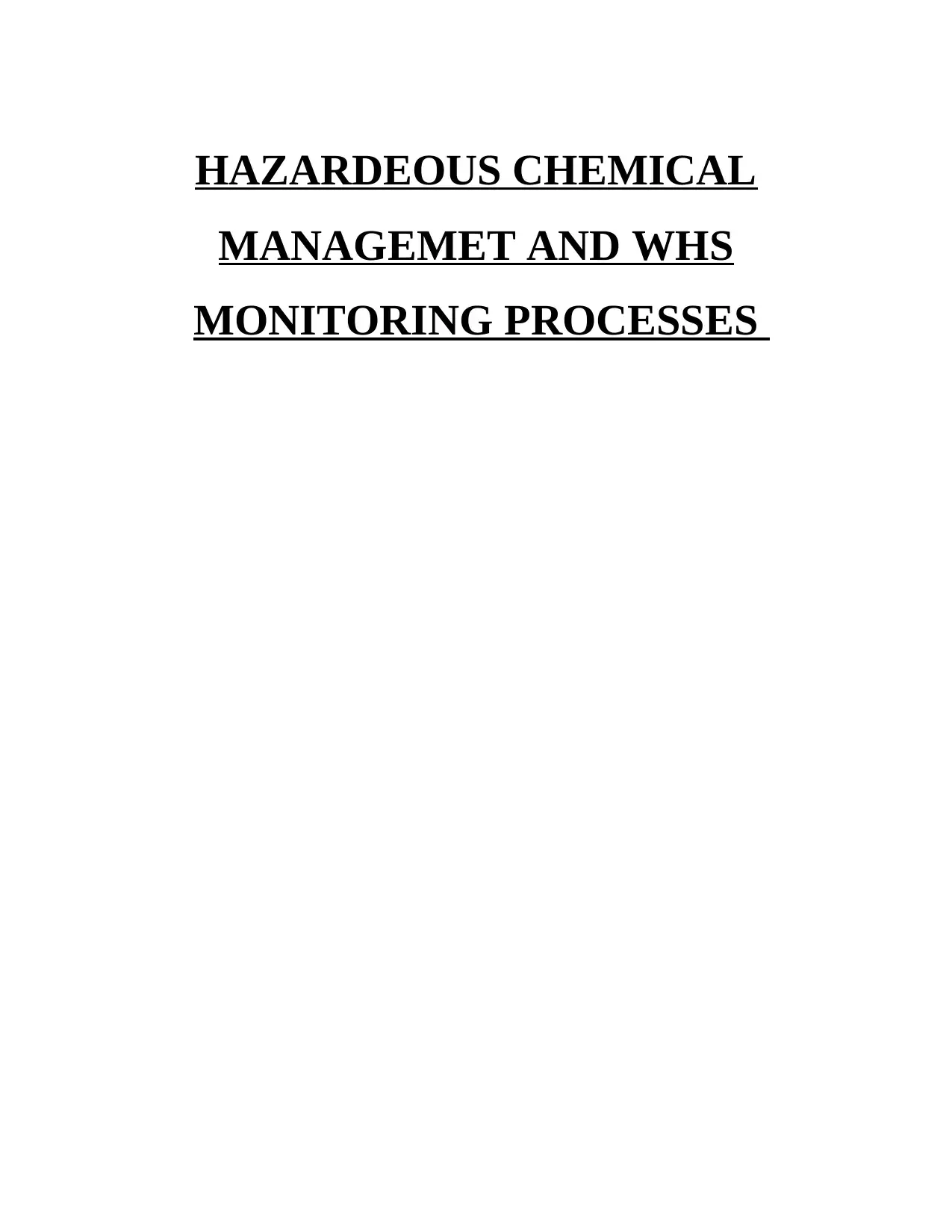
HAZARDEOUS CHEMICAL
MANAGEMET AND WHS
MONITORING PROCESSES
MANAGEMET AND WHS
MONITORING PROCESSES
Paraphrase This Document
Need a fresh take? Get an instant paraphrase of this document with our AI Paraphraser
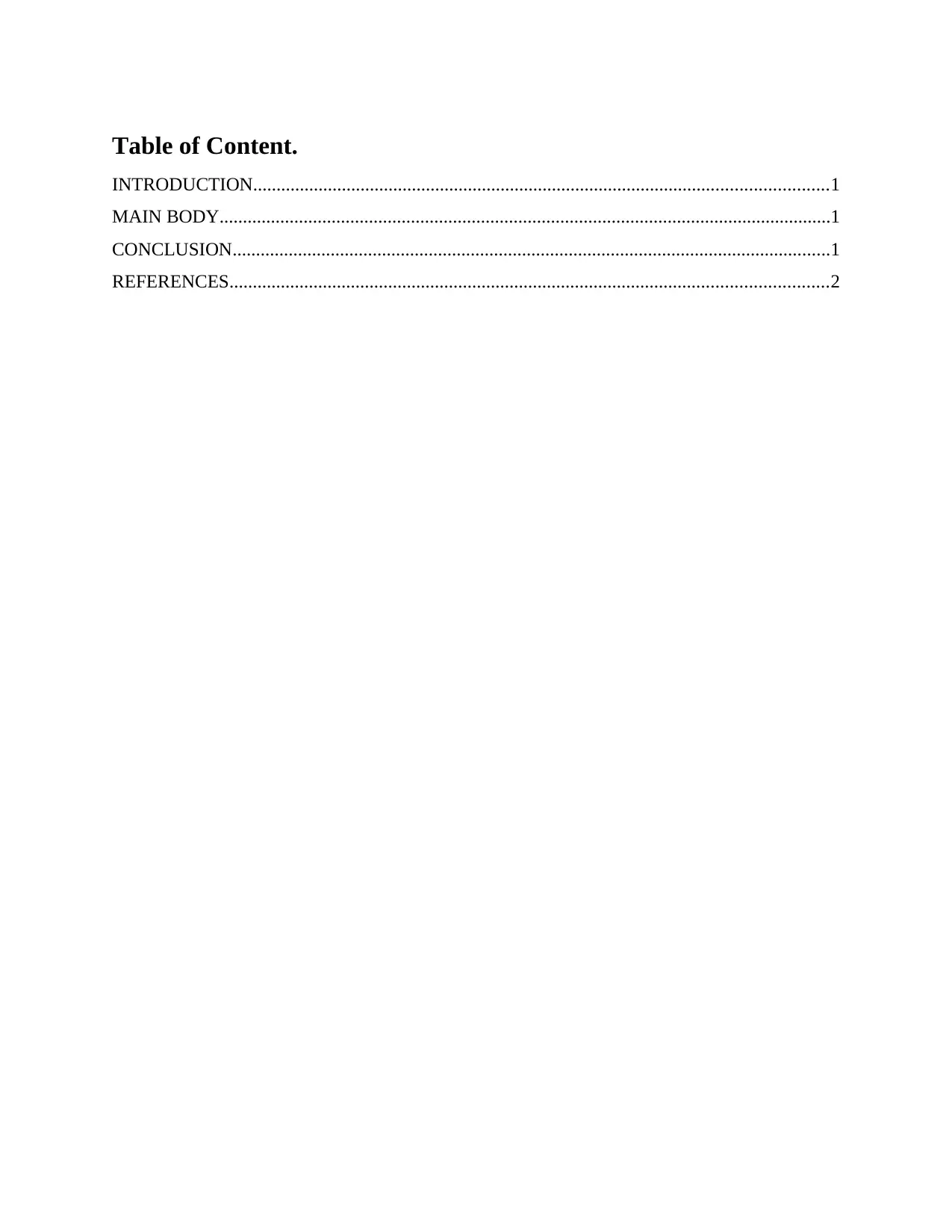
Table of Content.
INTRODUCTION...........................................................................................................................1
MAIN BODY...................................................................................................................................1
CONCLUSION................................................................................................................................1
REFERENCES................................................................................................................................2
INTRODUCTION...........................................................................................................................1
MAIN BODY...................................................................................................................................1
CONCLUSION................................................................................................................................1
REFERENCES................................................................................................................................2
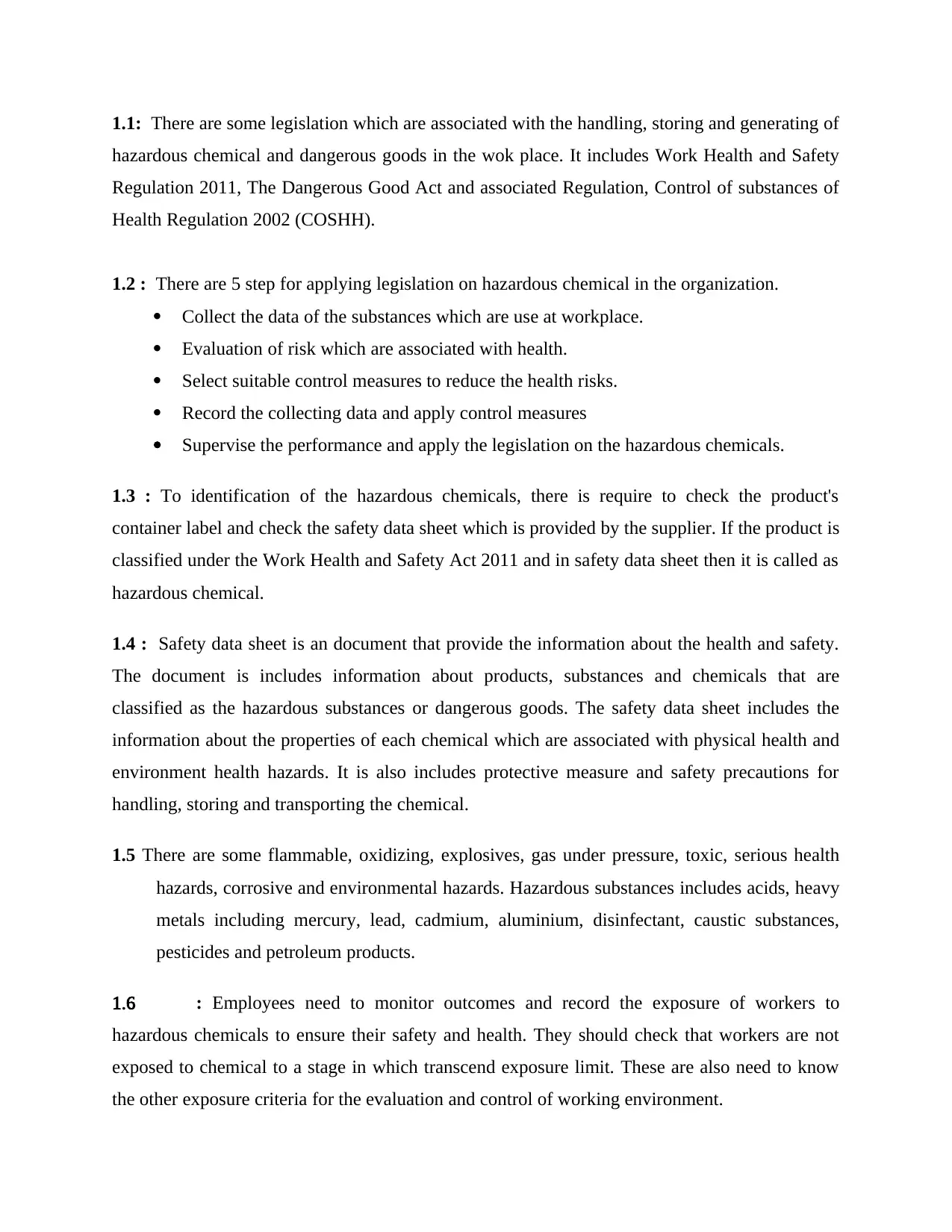
1.1: There are some legislation which are associated with the handling, storing and generating of
hazardous chemical and dangerous goods in the wok place. It includes Work Health and Safety
Regulation 2011, The Dangerous Good Act and associated Regulation, Control of substances of
Health Regulation 2002 (COSHH).
1.2 : There are 5 step for applying legislation on hazardous chemical in the organization.
Collect the data of the substances which are use at workplace.
Evaluation of risk which are associated with health.
Select suitable control measures to reduce the health risks.
Record the collecting data and apply control measures
Supervise the performance and apply the legislation on the hazardous chemicals.
1.3 : To identification of the hazardous chemicals, there is require to check the product's
container label and check the safety data sheet which is provided by the supplier. If the product is
classified under the Work Health and Safety Act 2011 and in safety data sheet then it is called as
hazardous chemical.
1.4 : Safety data sheet is an document that provide the information about the health and safety.
The document is includes information about products, substances and chemicals that are
classified as the hazardous substances or dangerous goods. The safety data sheet includes the
information about the properties of each chemical which are associated with physical health and
environment health hazards. It is also includes protective measure and safety precautions for
handling, storing and transporting the chemical.
1.5 There are some flammable, oxidizing, explosives, gas under pressure, toxic, serious health
hazards, corrosive and environmental hazards. Hazardous substances includes acids, heavy
metals including mercury, lead, cadmium, aluminium, disinfectant, caustic substances,
pesticides and petroleum products.
1.6 : Employees need to monitor outcomes and record the exposure of workers to
hazardous chemicals to ensure their safety and health. They should check that workers are not
exposed to chemical to a stage in which transcend exposure limit. These are also need to know
the other exposure criteria for the evaluation and control of working environment.
hazardous chemical and dangerous goods in the wok place. It includes Work Health and Safety
Regulation 2011, The Dangerous Good Act and associated Regulation, Control of substances of
Health Regulation 2002 (COSHH).
1.2 : There are 5 step for applying legislation on hazardous chemical in the organization.
Collect the data of the substances which are use at workplace.
Evaluation of risk which are associated with health.
Select suitable control measures to reduce the health risks.
Record the collecting data and apply control measures
Supervise the performance and apply the legislation on the hazardous chemicals.
1.3 : To identification of the hazardous chemicals, there is require to check the product's
container label and check the safety data sheet which is provided by the supplier. If the product is
classified under the Work Health and Safety Act 2011 and in safety data sheet then it is called as
hazardous chemical.
1.4 : Safety data sheet is an document that provide the information about the health and safety.
The document is includes information about products, substances and chemicals that are
classified as the hazardous substances or dangerous goods. The safety data sheet includes the
information about the properties of each chemical which are associated with physical health and
environment health hazards. It is also includes protective measure and safety precautions for
handling, storing and transporting the chemical.
1.5 There are some flammable, oxidizing, explosives, gas under pressure, toxic, serious health
hazards, corrosive and environmental hazards. Hazardous substances includes acids, heavy
metals including mercury, lead, cadmium, aluminium, disinfectant, caustic substances,
pesticides and petroleum products.
1.6 : Employees need to monitor outcomes and record the exposure of workers to
hazardous chemicals to ensure their safety and health. They should check that workers are not
exposed to chemical to a stage in which transcend exposure limit. These are also need to know
the other exposure criteria for the evaluation and control of working environment.
⊘ This is a preview!⊘
Do you want full access?
Subscribe today to unlock all pages.

Trusted by 1+ million students worldwide
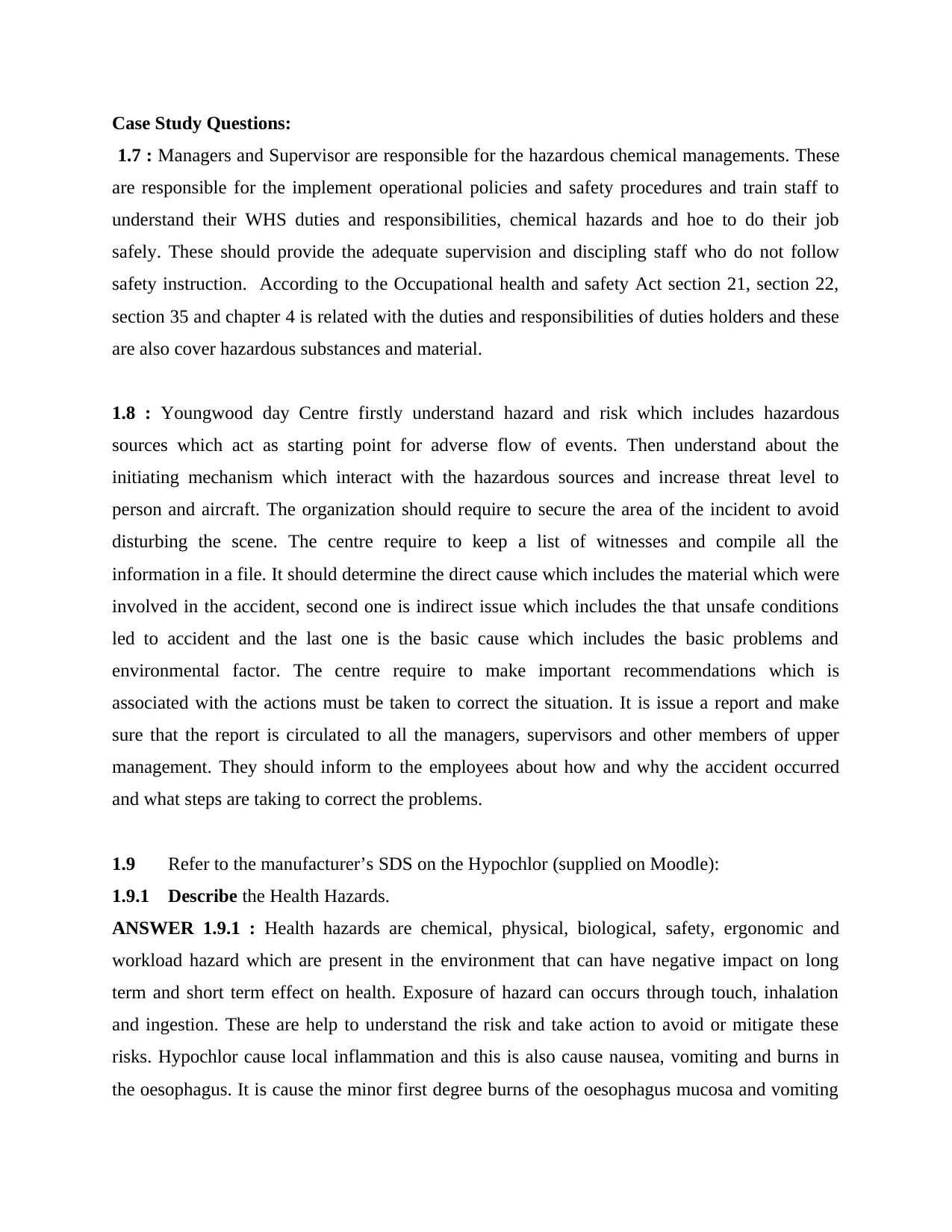
Case Study Questions:
1.7 : Managers and Supervisor are responsible for the hazardous chemical managements. These
are responsible for the implement operational policies and safety procedures and train staff to
understand their WHS duties and responsibilities, chemical hazards and hoe to do their job
safely. These should provide the adequate supervision and discipling staff who do not follow
safety instruction. According to the Occupational health and safety Act section 21, section 22,
section 35 and chapter 4 is related with the duties and responsibilities of duties holders and these
are also cover hazardous substances and material.
1.8 : Youngwood day Centre firstly understand hazard and risk which includes hazardous
sources which act as starting point for adverse flow of events. Then understand about the
initiating mechanism which interact with the hazardous sources and increase threat level to
person and aircraft. The organization should require to secure the area of the incident to avoid
disturbing the scene. The centre require to keep a list of witnesses and compile all the
information in a file. It should determine the direct cause which includes the material which were
involved in the accident, second one is indirect issue which includes the that unsafe conditions
led to accident and the last one is the basic cause which includes the basic problems and
environmental factor. The centre require to make important recommendations which is
associated with the actions must be taken to correct the situation. It is issue a report and make
sure that the report is circulated to all the managers, supervisors and other members of upper
management. They should inform to the employees about how and why the accident occurred
and what steps are taking to correct the problems.
1.9 Refer to the manufacturer’s SDS on the Hypochlor (supplied on Moodle):
1.9.1 Describe the Health Hazards.
ANSWER 1.9.1 : Health hazards are chemical, physical, biological, safety, ergonomic and
workload hazard which are present in the environment that can have negative impact on long
term and short term effect on health. Exposure of hazard can occurs through touch, inhalation
and ingestion. These are help to understand the risk and take action to avoid or mitigate these
risks. Hypochlor cause local inflammation and this is also cause nausea, vomiting and burns in
the oesophagus. It is cause the minor first degree burns of the oesophagus mucosa and vomiting
1.7 : Managers and Supervisor are responsible for the hazardous chemical managements. These
are responsible for the implement operational policies and safety procedures and train staff to
understand their WHS duties and responsibilities, chemical hazards and hoe to do their job
safely. These should provide the adequate supervision and discipling staff who do not follow
safety instruction. According to the Occupational health and safety Act section 21, section 22,
section 35 and chapter 4 is related with the duties and responsibilities of duties holders and these
are also cover hazardous substances and material.
1.8 : Youngwood day Centre firstly understand hazard and risk which includes hazardous
sources which act as starting point for adverse flow of events. Then understand about the
initiating mechanism which interact with the hazardous sources and increase threat level to
person and aircraft. The organization should require to secure the area of the incident to avoid
disturbing the scene. The centre require to keep a list of witnesses and compile all the
information in a file. It should determine the direct cause which includes the material which were
involved in the accident, second one is indirect issue which includes the that unsafe conditions
led to accident and the last one is the basic cause which includes the basic problems and
environmental factor. The centre require to make important recommendations which is
associated with the actions must be taken to correct the situation. It is issue a report and make
sure that the report is circulated to all the managers, supervisors and other members of upper
management. They should inform to the employees about how and why the accident occurred
and what steps are taking to correct the problems.
1.9 Refer to the manufacturer’s SDS on the Hypochlor (supplied on Moodle):
1.9.1 Describe the Health Hazards.
ANSWER 1.9.1 : Health hazards are chemical, physical, biological, safety, ergonomic and
workload hazard which are present in the environment that can have negative impact on long
term and short term effect on health. Exposure of hazard can occurs through touch, inhalation
and ingestion. These are help to understand the risk and take action to avoid or mitigate these
risks. Hypochlor cause local inflammation and this is also cause nausea, vomiting and burns in
the oesophagus. It is cause the minor first degree burns of the oesophagus mucosa and vomiting
Paraphrase This Document
Need a fresh take? Get an instant paraphrase of this document with our AI Paraphraser
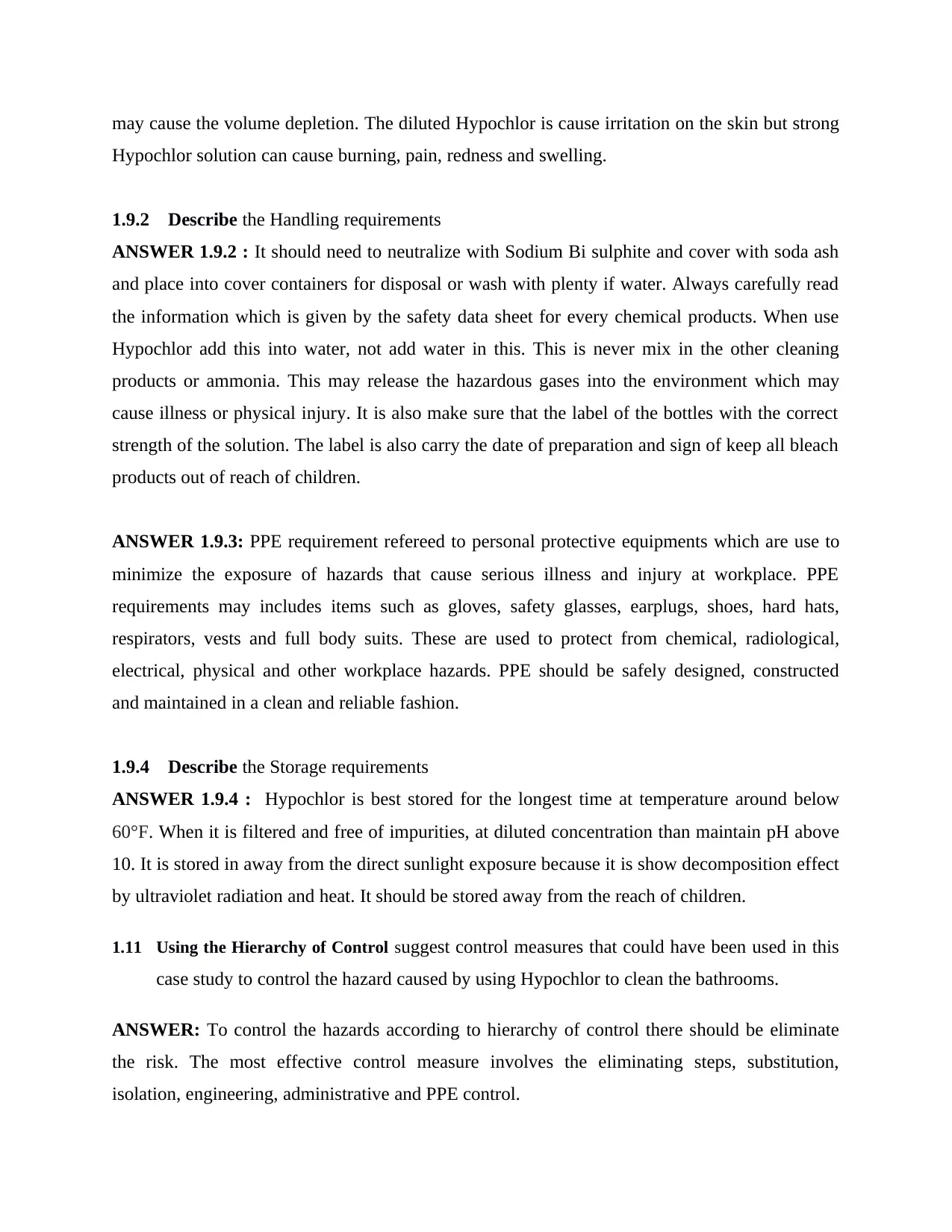
may cause the volume depletion. The diluted Hypochlor is cause irritation on the skin but strong
Hypochlor solution can cause burning, pain, redness and swelling.
1.9.2 Describe the Handling requirements
ANSWER 1.9.2 : It should need to neutralize with Sodium Bi sulphite and cover with soda ash
and place into cover containers for disposal or wash with plenty if water. Always carefully read
the information which is given by the safety data sheet for every chemical products. When use
Hypochlor add this into water, not add water in this. This is never mix in the other cleaning
products or ammonia. This may release the hazardous gases into the environment which may
cause illness or physical injury. It is also make sure that the label of the bottles with the correct
strength of the solution. The label is also carry the date of preparation and sign of keep all bleach
products out of reach of children.
ANSWER 1.9.3: PPE requirement refereed to personal protective equipments which are use to
minimize the exposure of hazards that cause serious illness and injury at workplace. PPE
requirements may includes items such as gloves, safety glasses, earplugs, shoes, hard hats,
respirators, vests and full body suits. These are used to protect from chemical, radiological,
electrical, physical and other workplace hazards. PPE should be safely designed, constructed
and maintained in a clean and reliable fashion.
1.9.4 Describe the Storage requirements
ANSWER 1.9.4 : Hypochlor is best stored for the longest time at temperature around below
60°F. When it is filtered and free of impurities, at diluted concentration than maintain pH above
10. It is stored in away from the direct sunlight exposure because it is show decomposition effect
by ultraviolet radiation and heat. It should be stored away from the reach of children.
1.11 Using the Hierarchy of Control suggest control measures that could have been used in this
case study to control the hazard caused by using Hypochlor to clean the bathrooms.
ANSWER: To control the hazards according to hierarchy of control there should be eliminate
the risk. The most effective control measure involves the eliminating steps, substitution,
isolation, engineering, administrative and PPE control.
Hypochlor solution can cause burning, pain, redness and swelling.
1.9.2 Describe the Handling requirements
ANSWER 1.9.2 : It should need to neutralize with Sodium Bi sulphite and cover with soda ash
and place into cover containers for disposal or wash with plenty if water. Always carefully read
the information which is given by the safety data sheet for every chemical products. When use
Hypochlor add this into water, not add water in this. This is never mix in the other cleaning
products or ammonia. This may release the hazardous gases into the environment which may
cause illness or physical injury. It is also make sure that the label of the bottles with the correct
strength of the solution. The label is also carry the date of preparation and sign of keep all bleach
products out of reach of children.
ANSWER 1.9.3: PPE requirement refereed to personal protective equipments which are use to
minimize the exposure of hazards that cause serious illness and injury at workplace. PPE
requirements may includes items such as gloves, safety glasses, earplugs, shoes, hard hats,
respirators, vests and full body suits. These are used to protect from chemical, radiological,
electrical, physical and other workplace hazards. PPE should be safely designed, constructed
and maintained in a clean and reliable fashion.
1.9.4 Describe the Storage requirements
ANSWER 1.9.4 : Hypochlor is best stored for the longest time at temperature around below
60°F. When it is filtered and free of impurities, at diluted concentration than maintain pH above
10. It is stored in away from the direct sunlight exposure because it is show decomposition effect
by ultraviolet radiation and heat. It should be stored away from the reach of children.
1.11 Using the Hierarchy of Control suggest control measures that could have been used in this
case study to control the hazard caused by using Hypochlor to clean the bathrooms.
ANSWER: To control the hazards according to hierarchy of control there should be eliminate
the risk. The most effective control measure involves the eliminating steps, substitution,
isolation, engineering, administrative and PPE control.
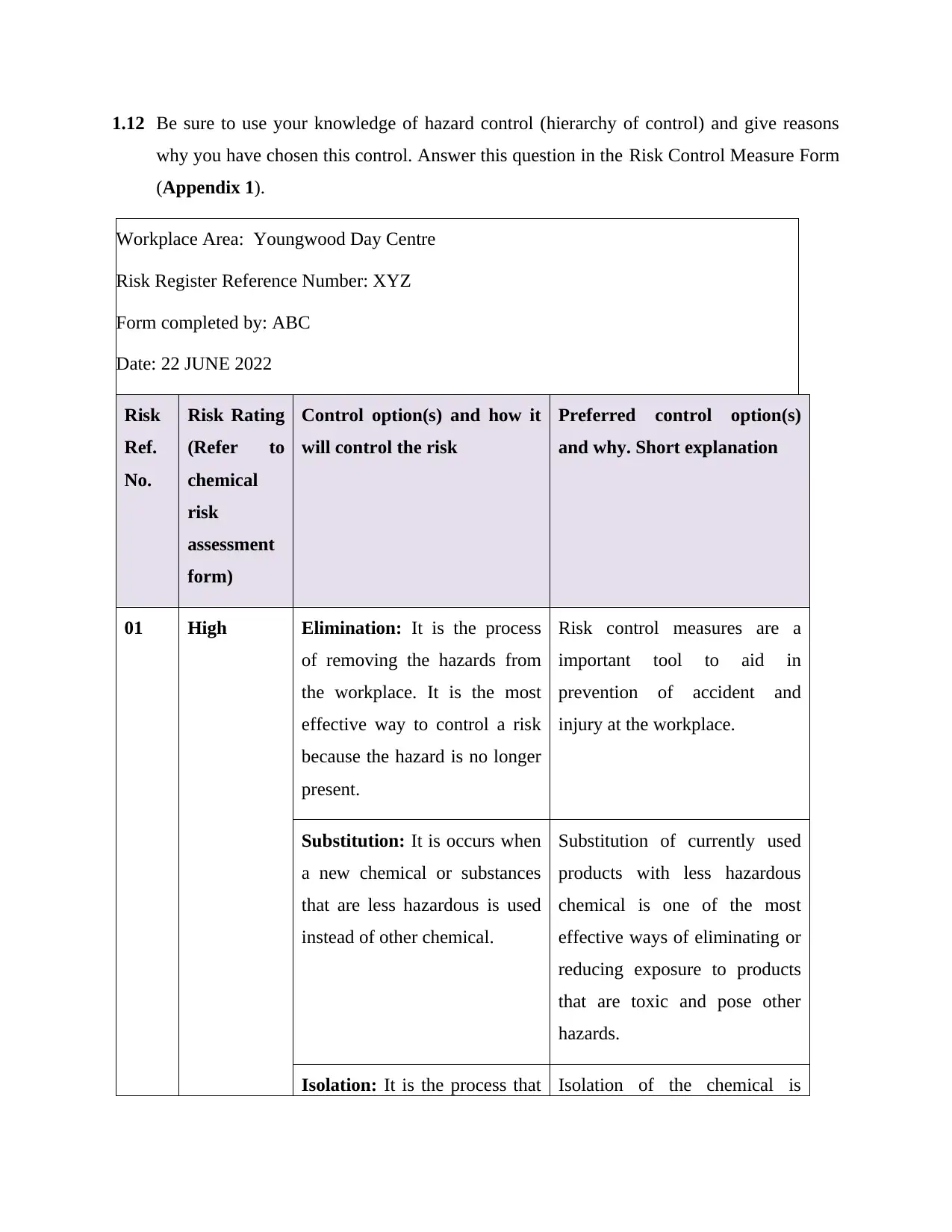
1.12 Be sure to use your knowledge of hazard control (hierarchy of control) and give reasons
why you have chosen this control. Answer this question in the Risk Control Measure Form
(Appendix 1).
Workplace Area: Youngwood Day Centre
Risk Register Reference Number: XYZ
Form completed by: ABC
Date: 22 JUNE 2022
Risk
Ref.
No.
Risk Rating
(Refer to
chemical
risk
assessment
form)
Control option(s) and how it
will control the risk
Preferred control option(s)
and why. Short explanation
01 High Elimination: It is the process
of removing the hazards from
the workplace. It is the most
effective way to control a risk
because the hazard is no longer
present.
Risk control measures are a
important tool to aid in
prevention of accident and
injury at the workplace.
Substitution: It is occurs when
a new chemical or substances
that are less hazardous is used
instead of other chemical.
Substitution of currently used
products with less hazardous
chemical is one of the most
effective ways of eliminating or
reducing exposure to products
that are toxic and pose other
hazards.
Isolation: It is the process that Isolation of the chemical is
why you have chosen this control. Answer this question in the Risk Control Measure Form
(Appendix 1).
Workplace Area: Youngwood Day Centre
Risk Register Reference Number: XYZ
Form completed by: ABC
Date: 22 JUNE 2022
Risk
Ref.
No.
Risk Rating
(Refer to
chemical
risk
assessment
form)
Control option(s) and how it
will control the risk
Preferred control option(s)
and why. Short explanation
01 High Elimination: It is the process
of removing the hazards from
the workplace. It is the most
effective way to control a risk
because the hazard is no longer
present.
Risk control measures are a
important tool to aid in
prevention of accident and
injury at the workplace.
Substitution: It is occurs when
a new chemical or substances
that are less hazardous is used
instead of other chemical.
Substitution of currently used
products with less hazardous
chemical is one of the most
effective ways of eliminating or
reducing exposure to products
that are toxic and pose other
hazards.
Isolation: It is the process that Isolation of the chemical is
⊘ This is a preview!⊘
Do you want full access?
Subscribe today to unlock all pages.

Trusted by 1+ million students worldwide
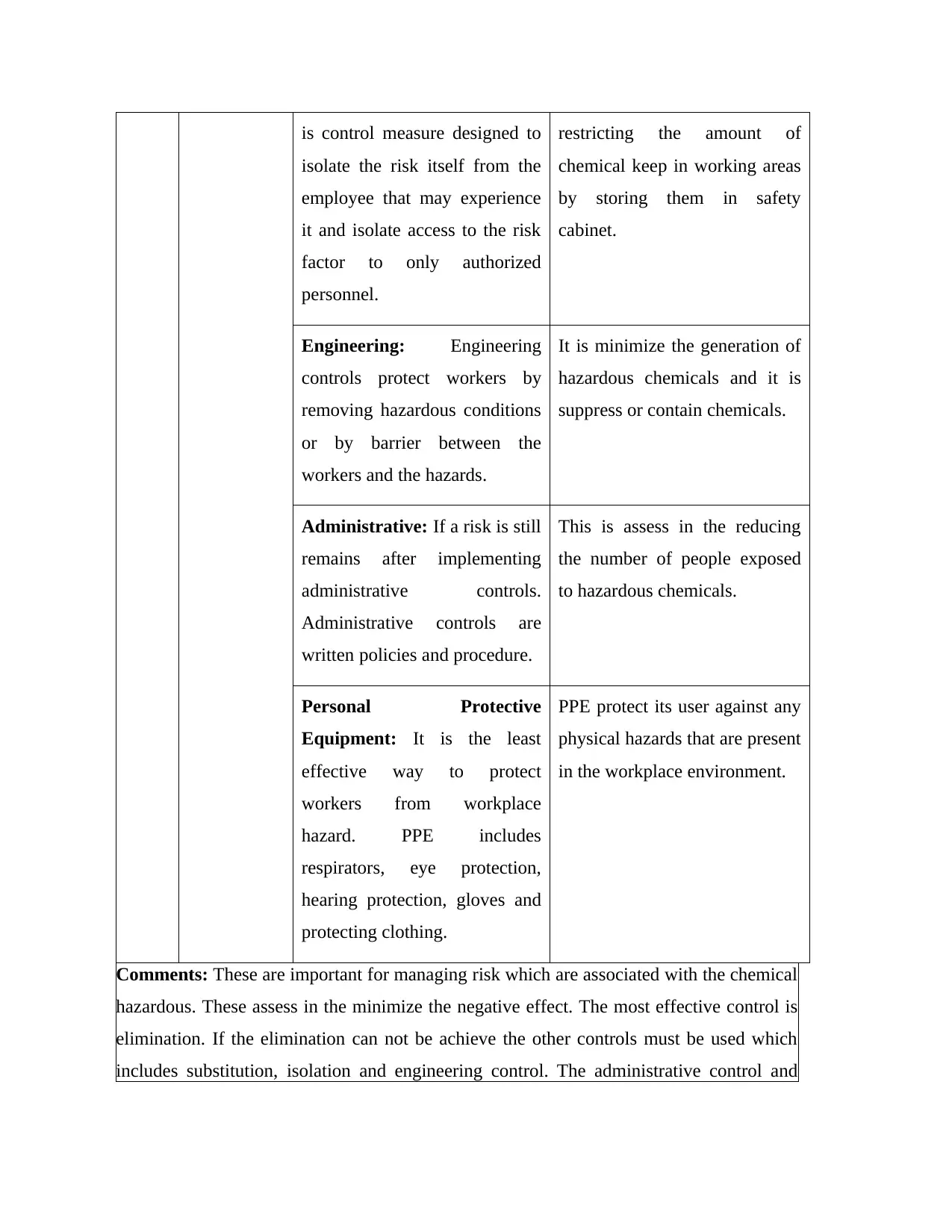
is control measure designed to
isolate the risk itself from the
employee that may experience
it and isolate access to the risk
factor to only authorized
personnel.
restricting the amount of
chemical keep in working areas
by storing them in safety
cabinet.
Engineering: Engineering
controls protect workers by
removing hazardous conditions
or by barrier between the
workers and the hazards.
It is minimize the generation of
hazardous chemicals and it is
suppress or contain chemicals.
Administrative: If a risk is still
remains after implementing
administrative controls.
Administrative controls are
written policies and procedure.
This is assess in the reducing
the number of people exposed
to hazardous chemicals.
Personal Protective
Equipment: It is the least
effective way to protect
workers from workplace
hazard. PPE includes
respirators, eye protection,
hearing protection, gloves and
protecting clothing.
PPE protect its user against any
physical hazards that are present
in the workplace environment.
Comments: These are important for managing risk which are associated with the chemical
hazardous. These assess in the minimize the negative effect. The most effective control is
elimination. If the elimination can not be achieve the other controls must be used which
includes substitution, isolation and engineering control. The administrative control and
isolate the risk itself from the
employee that may experience
it and isolate access to the risk
factor to only authorized
personnel.
restricting the amount of
chemical keep in working areas
by storing them in safety
cabinet.
Engineering: Engineering
controls protect workers by
removing hazardous conditions
or by barrier between the
workers and the hazards.
It is minimize the generation of
hazardous chemicals and it is
suppress or contain chemicals.
Administrative: If a risk is still
remains after implementing
administrative controls.
Administrative controls are
written policies and procedure.
This is assess in the reducing
the number of people exposed
to hazardous chemicals.
Personal Protective
Equipment: It is the least
effective way to protect
workers from workplace
hazard. PPE includes
respirators, eye protection,
hearing protection, gloves and
protecting clothing.
PPE protect its user against any
physical hazards that are present
in the workplace environment.
Comments: These are important for managing risk which are associated with the chemical
hazardous. These assess in the minimize the negative effect. The most effective control is
elimination. If the elimination can not be achieve the other controls must be used which
includes substitution, isolation and engineering control. The administrative control and
Paraphrase This Document
Need a fresh take? Get an instant paraphrase of this document with our AI Paraphraser
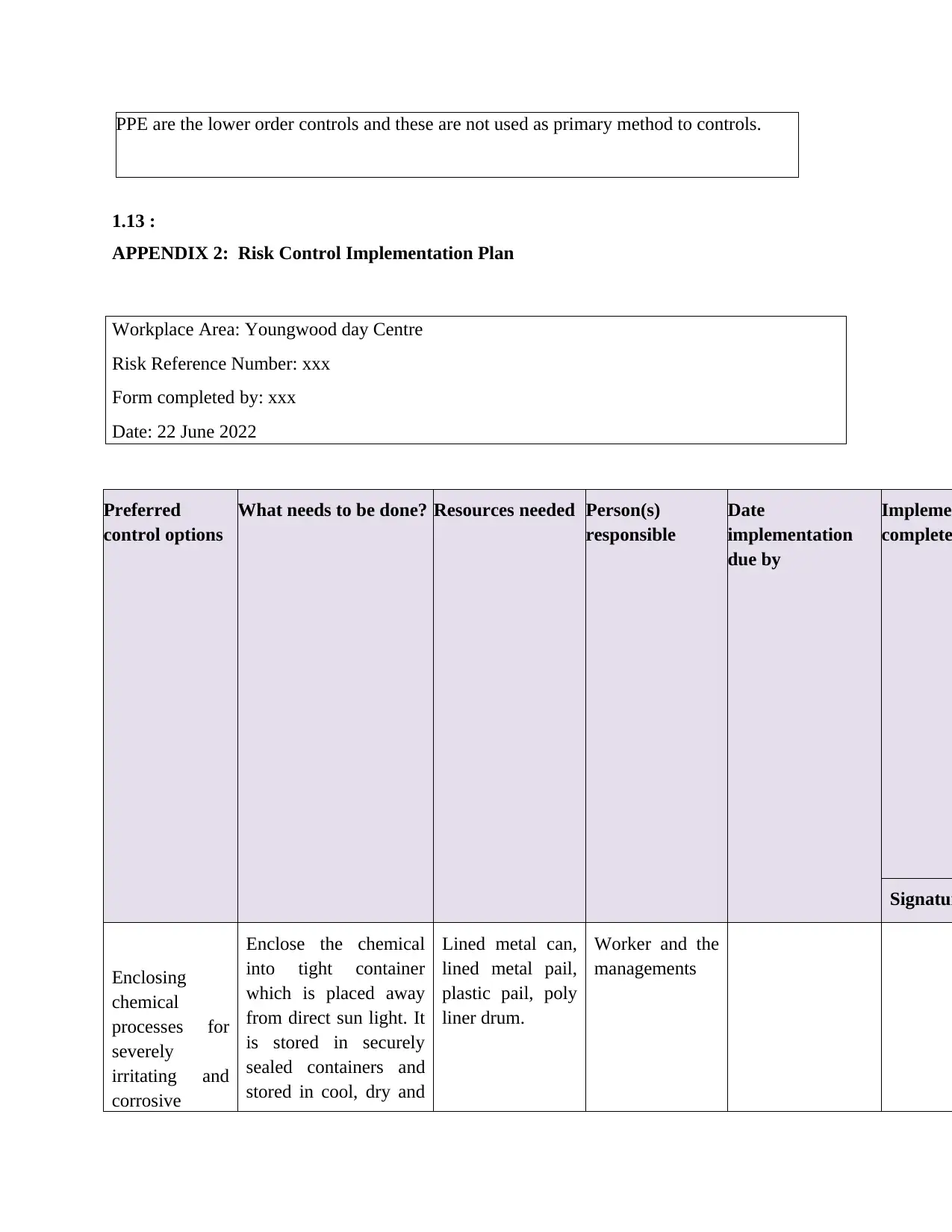
PPE are the lower order controls and these are not used as primary method to controls.
1.13 :
APPENDIX 2: Risk Control Implementation Plan
Workplace Area: Youngwood day Centre
Risk Reference Number: xxx
Form completed by: xxx
Date: 22 June 2022
Preferred
control options
What needs to be done? Resources needed Person(s)
responsible
Date
implementation
due by
Implemen
complete
Signatur
Enclosing
chemical
processes for
severely
irritating and
corrosive
Enclose the chemical
into tight container
which is placed away
from direct sun light. It
is stored in securely
sealed containers and
stored in cool, dry and
Lined metal can,
lined metal pail,
plastic pail, poly
liner drum.
Worker and the
managements
1.13 :
APPENDIX 2: Risk Control Implementation Plan
Workplace Area: Youngwood day Centre
Risk Reference Number: xxx
Form completed by: xxx
Date: 22 June 2022
Preferred
control options
What needs to be done? Resources needed Person(s)
responsible
Date
implementation
due by
Implemen
complete
Signatur
Enclosing
chemical
processes for
severely
irritating and
corrosive
Enclose the chemical
into tight container
which is placed away
from direct sun light. It
is stored in securely
sealed containers and
stored in cool, dry and
Lined metal can,
lined metal pail,
plastic pail, poly
liner drum.
Worker and the
managements
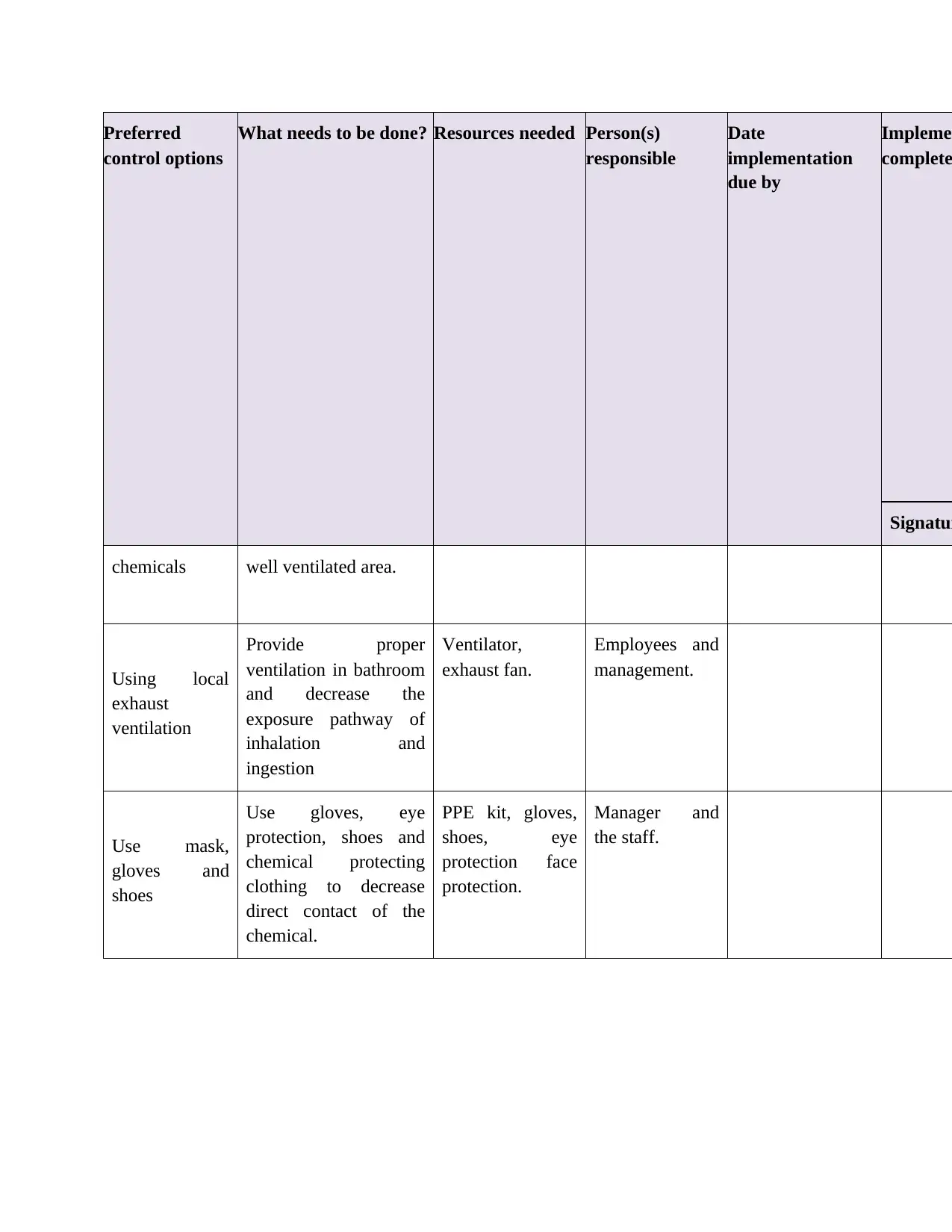
Preferred
control options
What needs to be done? Resources needed Person(s)
responsible
Date
implementation
due by
Implemen
complete
Signatur
chemicals well ventilated area.
Using local
exhaust
ventilation
Provide proper
ventilation in bathroom
and decrease the
exposure pathway of
inhalation and
ingestion
Ventilator,
exhaust fan.
Employees and
management.
Use mask,
gloves and
shoes
Use gloves, eye
protection, shoes and
chemical protecting
clothing to decrease
direct contact of the
chemical.
PPE kit, gloves,
shoes, eye
protection face
protection.
Manager and
the staff.
control options
What needs to be done? Resources needed Person(s)
responsible
Date
implementation
due by
Implemen
complete
Signatur
chemicals well ventilated area.
Using local
exhaust
ventilation
Provide proper
ventilation in bathroom
and decrease the
exposure pathway of
inhalation and
ingestion
Ventilator,
exhaust fan.
Employees and
management.
Use mask,
gloves and
shoes
Use gloves, eye
protection, shoes and
chemical protecting
clothing to decrease
direct contact of the
chemical.
PPE kit, gloves,
shoes, eye
protection face
protection.
Manager and
the staff.
⊘ This is a preview!⊘
Do you want full access?
Subscribe today to unlock all pages.

Trusted by 1+ million students worldwide
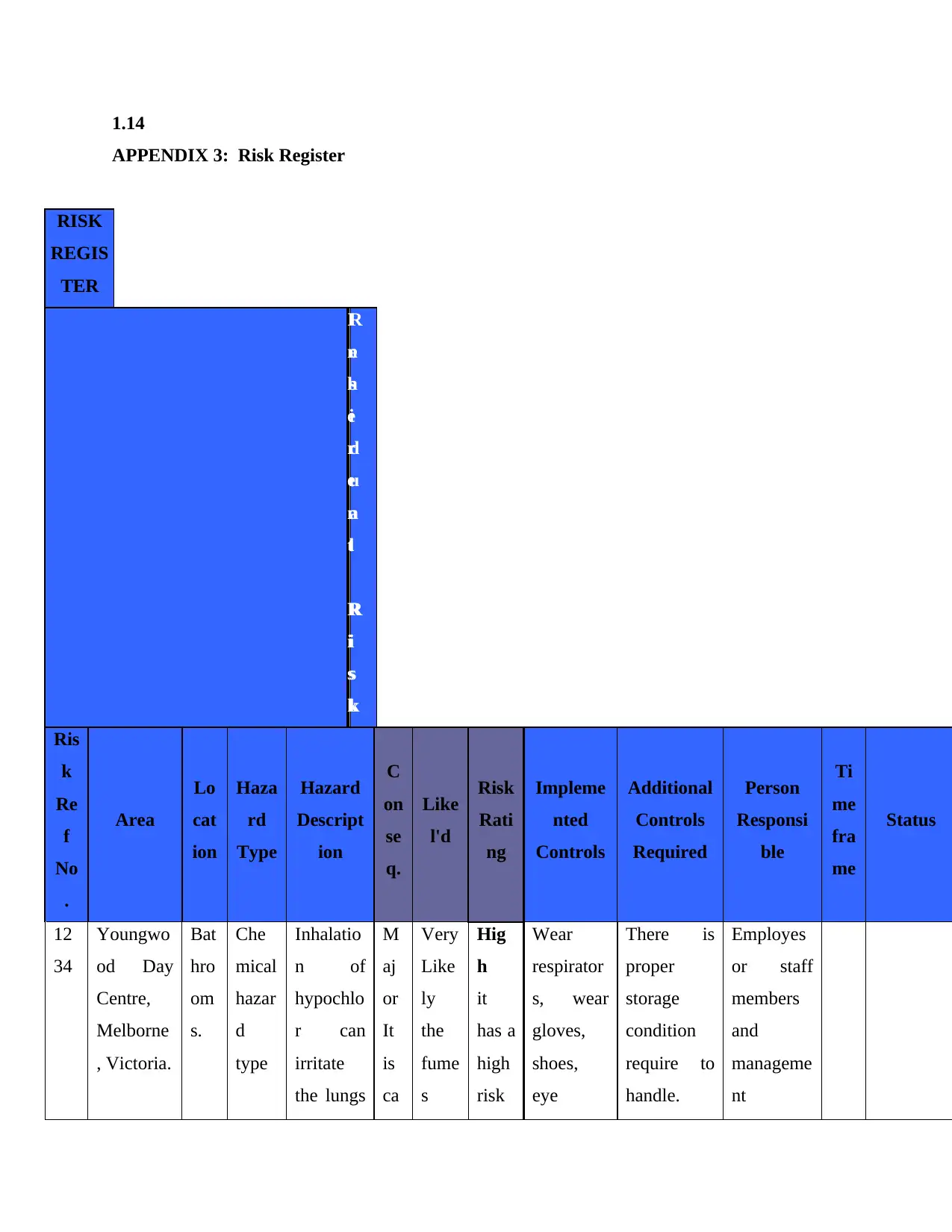
1.14
APPENDIX 3: Risk Register
RISK
REGIS
TER
I
n
h
e
r
e
n
t
R
i
s
k
R
e
s
i
d
u
a
l
R
i
s
k
Ris
k
Re
f
No
.
Area
Lo
cat
ion
Haza
rd
Type
Hazard
Descript
ion
C
on
se
q.
Like
l'd
Risk
Rati
ng
Impleme
nted
Controls
Additional
Controls
Required
Person
Responsi
ble
Ti
me
fra
me
Status
12
34
Youngwo
od Day
Centre,
Melborne
, Victoria.
Bat
hro
om
s.
Che
mical
hazar
d
type
Inhalatio
n of
hypochlo
r can
irritate
the lungs
M
aj
or
It
is
ca
Very
Like
ly
the
fume
s
Hig
h
it
has a
high
risk
Wear
respirator
s, wear
gloves,
shoes,
eye
There is
proper
storage
condition
require to
handle.
Employes
or staff
members
and
manageme
nt
APPENDIX 3: Risk Register
RISK
REGIS
TER
I
n
h
e
r
e
n
t
R
i
s
k
R
e
s
i
d
u
a
l
R
i
s
k
Ris
k
Re
f
No
.
Area
Lo
cat
ion
Haza
rd
Type
Hazard
Descript
ion
C
on
se
q.
Like
l'd
Risk
Rati
ng
Impleme
nted
Controls
Additional
Controls
Required
Person
Responsi
ble
Ti
me
fra
me
Status
12
34
Youngwo
od Day
Centre,
Melborne
, Victoria.
Bat
hro
om
s.
Che
mical
hazar
d
type
Inhalatio
n of
hypochlo
r can
irritate
the lungs
M
aj
or
It
is
ca
Very
Like
ly
the
fume
s
Hig
h
it
has a
high
risk
Wear
respirator
s, wear
gloves,
shoes,
eye
There is
proper
storage
condition
require to
handle.
Employes
or staff
members
and
manageme
nt
Paraphrase This Document
Need a fresh take? Get an instant paraphrase of this document with our AI Paraphraser
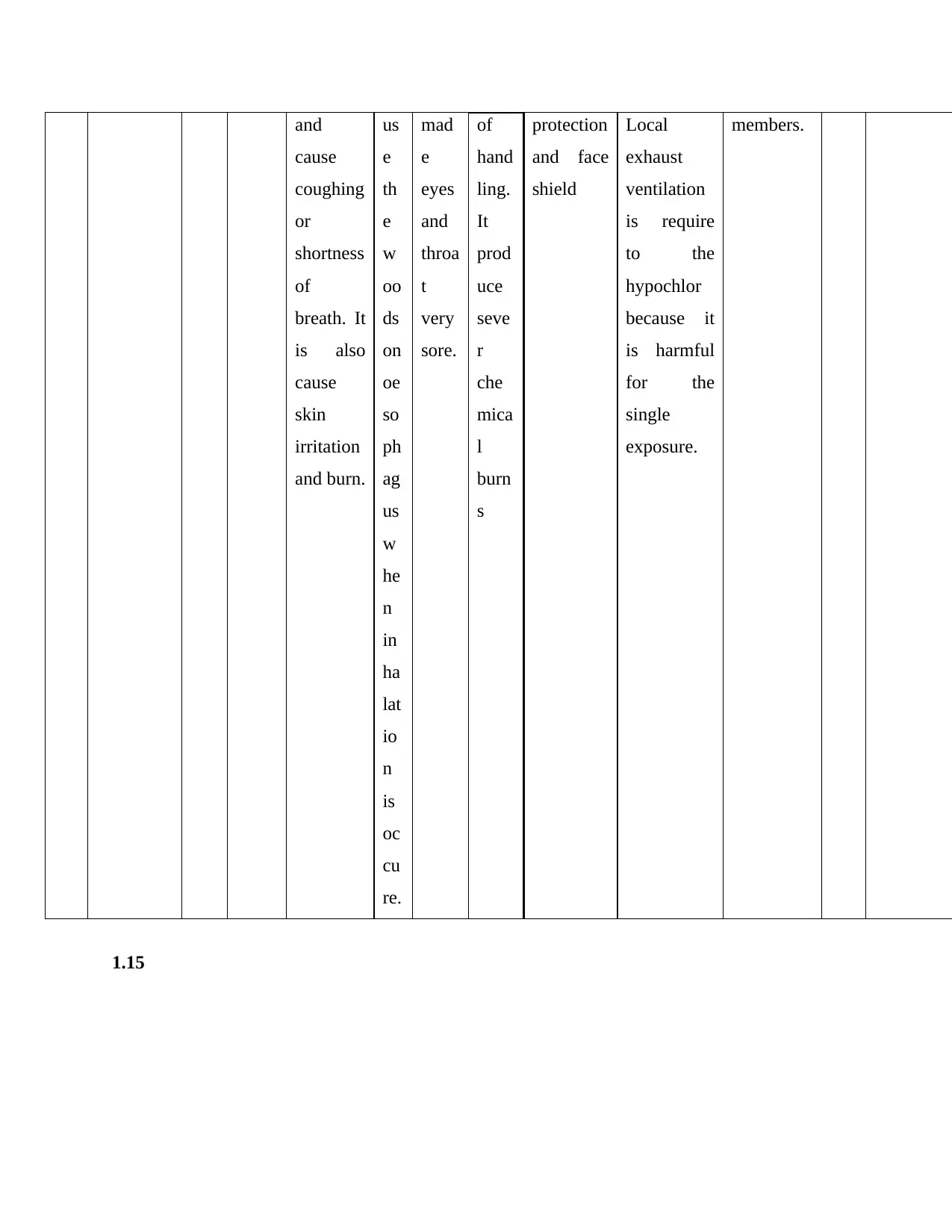
and
cause
coughing
or
shortness
of
breath. It
is also
cause
skin
irritation
and burn.
us
e
th
e
w
oo
ds
on
oe
so
ph
ag
us
w
he
n
in
ha
lat
io
n
is
oc
cu
re.
mad
e
eyes
and
throa
t
very
sore.
of
hand
ling.
It
prod
uce
seve
r
che
mica
l
burn
s
protection
and face
shield
Local
exhaust
ventilation
is require
to the
hypochlor
because it
is harmful
for the
single
exposure.
members.
1.15
cause
coughing
or
shortness
of
breath. It
is also
cause
skin
irritation
and burn.
us
e
th
e
w
oo
ds
on
oe
so
ph
ag
us
w
he
n
in
ha
lat
io
n
is
oc
cu
re.
mad
e
eyes
and
throa
t
very
sore.
of
hand
ling.
It
prod
uce
seve
r
che
mica
l
burn
s
protection
and face
shield
Local
exhaust
ventilation
is require
to the
hypochlor
because it
is harmful
for the
single
exposure.
members.
1.15
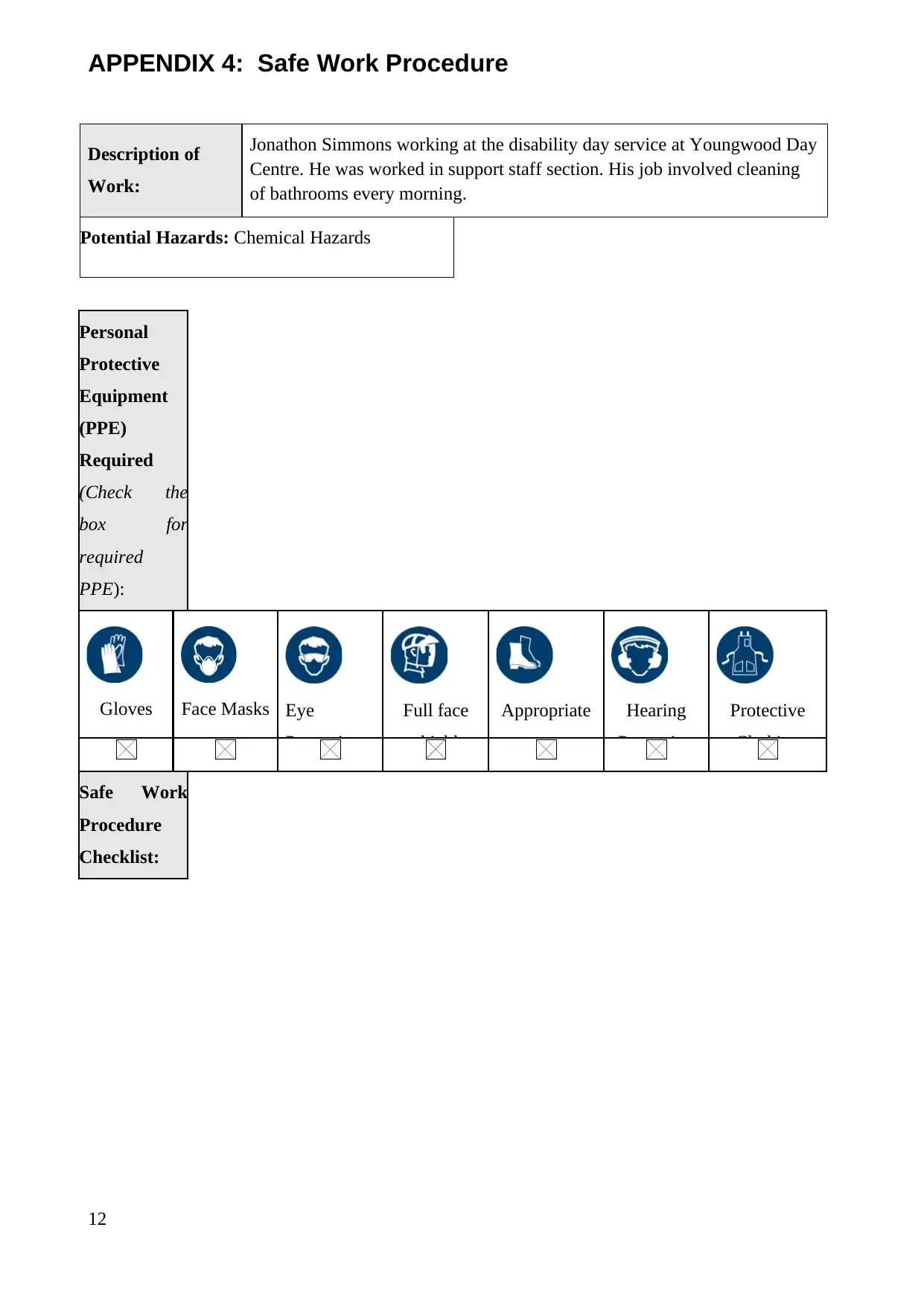
APPENDIX 4: Safe Work Procedure
Description of
Work:
Jonathon Simmons working at the disability day service at Youngwood Day
Centre. He was worked in support staff section. His job involved cleaning
of bathrooms every morning.
Potential Hazards: Chemical Hazards
Personal
Protective
Equipment
(PPE)
Required
(Check the
box for
required
PPE):
Gloves Face Masks Eye
Protection
Full face
shield
Appropriate Hearing
Protection
Protective
Clothing
Safe Work
Procedure
Checklist:
12
Description of
Work:
Jonathon Simmons working at the disability day service at Youngwood Day
Centre. He was worked in support staff section. His job involved cleaning
of bathrooms every morning.
Potential Hazards: Chemical Hazards
Personal
Protective
Equipment
(PPE)
Required
(Check the
box for
required
PPE):
Gloves Face Masks Eye
Protection
Full face
shield
Appropriate Hearing
Protection
Protective
Clothing
Safe Work
Procedure
Checklist:
12
⊘ This is a preview!⊘
Do you want full access?
Subscribe today to unlock all pages.

Trusted by 1+ million students worldwide
1 out of 17
Related Documents
Your All-in-One AI-Powered Toolkit for Academic Success.
+13062052269
info@desklib.com
Available 24*7 on WhatsApp / Email
![[object Object]](/_next/static/media/star-bottom.7253800d.svg)
Unlock your academic potential
Copyright © 2020–2025 A2Z Services. All Rights Reserved. Developed and managed by ZUCOL.





